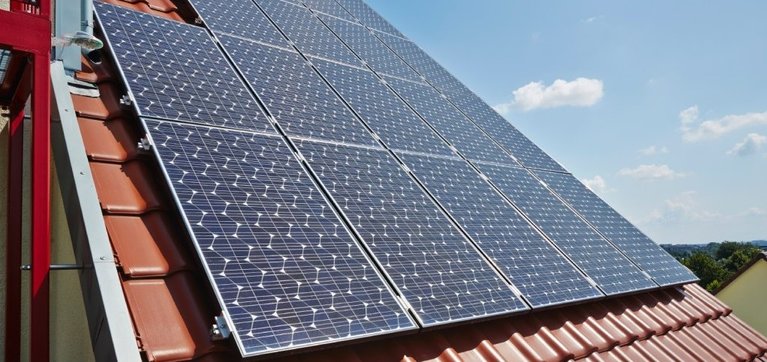Launch of a fourth solar scheme for promoting rooftop solar (RTS) adoption is widely seen as a shot in the arm for India’s clean energy initiatives. It aims to install RTS panels at one-crore low-and middle-income houses, which is estimated to add 25-30 GW of new solar power capacity. The scheme is designed in such a way that it provides free electricity up to 300 units a month to the households and monetizes their surplus power.
Earlier, the country had launched three schemes to accelerate solar adoption. In the recently announced Pradhan Mantri Suryodaya Yojana (PMSY) Scheme, higher subsidies have been offered to the grid-connected residential RTS plants deployed with domestically manufactured solar modules.
But the progress on this front was not very encouraging as the energy sector is beset with numerous legacy issues. Further, the state-run power distribution companies’ disinterest to push renewable energy projects, lack of awareness among the target groups, high initial investments, and poor financing options were the other reasons that hampered the grassroots-level implementation.

Credit Fair
RTS has a personal connect with people as it directly brightens up every individual household and it has the potential to improve household finances. It provides affordable power, reduces dependency on the power distribution companies, and provides electricity even in tough terrains where the state-owned companies refuse to serve.
According to a recent report by the Council on Energy, Environment and Water (CEEW), over 250 million households across the country have the potential to deploy 637 GW of solar capacity on rooftops. However, as of December 2023, India installed only 11.08 GW of grid-connected RTS against a target of 40 GW. Ground-mounted solar plants contributed 56.92 GW.
Notably, there is a huge potential for solar power generation in the commercial and industrial (C&I) RTS segment. The C&I consumers account for about 80% of the 11.08 GW grid-connected RTS as they enjoy viable financing options. The established lenders like the public-sector banks and scheduled commercial banks are ready to finance C&I solar projects, including those of MSMEs [micro, small and medium enterprises], as they have a successful bankable model compared to the residential RTS.
According to JMK Research and Analytics’ latest (Oct.-Dec. 2023) report, about 6.5 GW of new utility-scale solar capacity was added in 2023. In the rooftop segment, there was 3 GW installation, registering a growth of 58% compared to 2022.
India’s total renewables capacity reached 133.88 GW at the end of 2023, the report said. Solar continues to be the major contributor with a 55% share in the total renewable energy mix. Wind has a 33% share. The current pipeline of combined capacity of solar, wind and hybrid projects is around 86 GW, which is likely to be completed in the next 5-7 years, the report added.
As a clear indication of the rising domestic demand, solar module imports increased 138%, and solar module exports fell 38.5% in Q3FY24. The rise in imports is mainly due to a steep fall in the global solar module prices. This year, about 20.6 GW of new solar capacity is likely to be added in the country. In this, 4 GW is expected to be from the RTS.
What drives the commercial establishments to the renewable energy sources is their constantly rising power tariffs and unmet power demand. Also, adoption of clean energy practices and low-carbon emission technology offers additional incentives. The C&I segment consumes approximately 49% of power produced in India, but only 3.5% of their consumption comes from renewable sources. Within the C&I segment, MSME units are more keen to tap solar energy as electricity costs account for up to 50% of their total expenses.
The increasing solar adoption in the C&I segment will have far-reaching effects in the economy as well. Since the industrial consumers are the cash cow of state-owned power utilities, any shakeup in their core customer base will force the utilities to change their tack. Further, it will fast track streamlining of many regulatory issues such as net metering, supply of renewable energy to the grid, unit pricing, and long-term power purchase obligations.
Beating all the odds, India’s renewable energy capacity addition is moving on a fast lane and the C&I segment is expected to reinvigorate the RTS adoption further. The trend, along with the PMSY scheme, will trigger a substantial jump in the demand for solar panels, modules, inverters, and other power accessories in the country. Above all, there will be a huge demand for the skilled labour force, which is essential to run the scheme.
The views and opinions expressed in this article are the author’s own, and do not necessarily reflect those held by pv magazine.
This content is protected by copyright and may not be reused. If you want to cooperate with us and would like to reuse some of our content, please contact: editors@pv-magazine.com.








Стоимость доставки за пределы МКАД составит 30 руб. за 1 км.Баскетбольное кольцо.
http://multigonka.com.ua/index.php?go_id=viewuser&u_id=416
http://www.fc-lubertsy.ru/best_players.html
http://fansfcsevastopol.com/euro12/
Согласно строительным нормам в каждом дворе многоэтажного дома должна находиться детская игровая площадка. Но ведь не только детям нужно развлекаться и играть. Взрослым нужно понемногу тренироваться, заниматься физкультурой, чтобы поддерживать себя в нормальной физической форме. А подросткам просто необходимо физически развиваться, причем лучше всего это делать на открытом воздухе, а не в душном тренажерном зале. Именно для этого компания IgroSport начала выпускать уличные спортивные тренажеры, которые можно устанавливать практически в каждом дворе, где есть хоть десяток квадратных метров свободной площади.Большой ассортимент электромобилей.